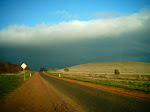
20.2.10
being at a loss
 In 'The Infinite Conversation' (Theory and History of Literature). Blanchot writes:
"The book: a ruse by which writing goest toward the absence of the book." (p. 424)
Why is this idea, the idea of absence, loss, something missing, so attractive? .
Because it propels desire in all the ways of desire, because it has the shape of something of some of us. Is it a beautiful envelope of an idea? I could say no more about it: I was at a loss. It worked as an aporia.
In 'The Infinite Conversation' (Theory and History of Literature). Blanchot writes:
"The book: a ruse by which writing goest toward the absence of the book." (p. 424)
Why is this idea, the idea of absence, loss, something missing, so attractive? .
Because it propels desire in all the ways of desire, because it has the shape of something of some of us. Is it a beautiful envelope of an idea? I could say no more about it: I was at a loss. It worked as an aporia.This was a painting of his friend Marat who had just been murdered in the French Revolution.
Imagine painting the death scene of a friend, it is quite an act of love.
I wondered if someone had commissioned the painting or if David had painted it off his own back. This is when I found something interesting.
David was commissioned to paint the portrait of his friend by a patron who requested that the painting remain faithful to David’s style in ‘The Death of Lepeletier de Saint-Fargeau’. In January 1793 Saint-Fargeau was murdered and soon after, David painted a representation of a moment of his death, placing him as the first martyr of the French Revolution.
The two paintings, Saint-Fargau and Marat (the two men) were to remain together as an informal diptych and were always displayed together until David's death when they were separated. ‘The Death of Lepeletier de Saint-Fargeau’ has in fact gone missing or has been destroyed - there are contrary reports.
So, the painting of Marat has a missing piece, it is a painting that moves me towards and away from an absence. It is at a loss. It is not at home and by it neither am I.
5.2.10
making bread
Subscribe to:
Posts (Atom)


